Textus Receptus Bibles
Are Older Manuscripts More Reliable?
In the world of manuscripts, "older" does not mean "more reliable". There are three reasons for this. First, the farther back in time we go, the more skewed and unrepresentative the evidence becomes. Second, there is no scientific correlation between the age of a manuscript and its number of copyist errors. Third, the existence of modern critical texts ironically rebuts the presumption that only old manuscripts contain reliable readings.
Evidence becomes skewed the farther back we go
Manuscripts in Alexandria were corrupt by 200 AD
The oldest New Testament manuscript fragment is P52, which dates to about 125 AD. However, the earliest manuscripts that provide distinguishable readings date to about 200 AD (e.g. P46, P66). These manuscripts come from Egypt and are witnesses of the Alexandrian text-type. However, the antiquity of these manuscripts is no indication of reliability because a prominent church father in Alexandria testified that manuscripts were already corrupt by the third century. Origen, the Alexandrian church father in the early third century, said:
"...the differences among the manuscripts [of the Gospels] have become great, either through the negligence of some copyists or through the perverse audacity of others; they either neglect to check over what they have transcribed, or, in the process of checking, they lengthen or shorten, as they please."
(Bruce Metzger, The Text of the New Testament: Its Transmission, Corruption, and Restoration, 3rd ed. (1991), pp. 151-152).
Origen is of course speaking of the manuscripts of his location, Alexandria, Egypt. By an Alexandrian Church father's own admission, manuscripts in Alexandria by 200 AD were already corrupt. Irenaeus in the 2nd century, though not in Alexandria, made a similar admission on the state of corruption among New Testament manuscripts. Daniel B. Wallace says, "Revelation was copied less often than any other book of the NT, and yet Irenaeus admits that it was already corrupted—within just a few decades of the writing of the Apocalypse" (Online article: Did the Original New Testament Manuscripts still exist in the Second Century?). In other words, blindly preferring the "oldest" manuscripts does not ensure arriving at the correct readings. For the antiquity of a manuscript to be of intrinsic value, that manuscript must be from before 200 AD when the corruptions were already evident. This is not the case with any extant Alexandrian manuscript.
Egypt, Egypt, Egypt
The "oldest" extant manuscripts (those from before the 5th century) which NA/UBS scholars rely on as reliable are all from Egypt, the place where Origen observed the corruption of manuscripts:
- Codex Sinaiticus (Mount Sinai, Egypt)
- Codex Alexandrinus (Alexandria, Egypt)
- Codex Vaticanus (Alexandria, Egypt)
- Uncial 0220 (Cairo, Egypt)
- Uncial 0162 (Oxyrhynchus, Egypt)
- Uncial 0206 (Oxyrhynchus, Egypt)
- Amherst Papyri (Egypt)
- Bodmer papyri (Pabau, Egypt)
- Chester Beatty papyri (Fayum or Aphroditopolis, Egypt)
- Michigan papyri (Egypt)
- Oxyrhynchus papyri (Oxyrhynchus, Egypt)
- Rylands papyri (Egypt)
-
Miscellaneous papyri:
- P2 (Egypt), P4 (Coptos, Egypt) P6 (Egypt), P7 (Egypt), P8 (Egypt), P12 (Egypt), P14 (Mount Sinai, Egypt), P25 (Egypt), P33=58 (Egypt), P34 (Egypt), P35 (Egypt), P36 (Egypt), P40 (Egypt), P41 (Egypt), P43 (Egypt), P44 (Egypt), P48 (Egypt), P49 (Egypt), P50 (Egypt), P52 (Egypt), P53 (Egypt), P54 (Egypt), P55 (Egypt), P56 (Egypt), P57 (Egypt), P59 (Egypt), P60 (Egypt), P61 (Egypt), P62 (Egypt), P63 (Egypt), P64=67 (Coptos, Egypt), P65 (Egypt), P68 (Egypt), P76 (Egypt), P79 (Egypt), P80 (Egypt), P81 (Egypt), P82 (Egypt), P83 (Egypt), P84 (Egypt), P85 (Egypt), P86 (Egypt), P88 (Egypt), P89 (Egypt), P92 (Faiyum, Egypt)
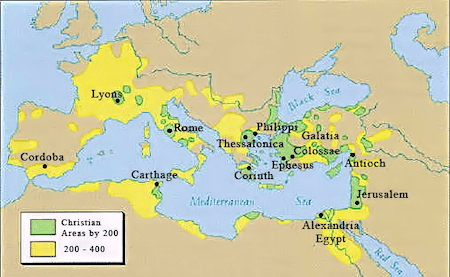
Egypt was just one region where Christianity took root
Early churches spanned across the Roman Empire from Carthage to Antioch to Cappadocia to Rome to Spain. In fact, Egypt did not receive any of the autographs from the Apostles. Thus in reconstructing the Greek New Testament text it is erroneous to focus predominantly on Egyptian witnesses just by the virtue of them being the oldest. Since early churches were isolated because of persecution, it is questionable to assume that readings found in 2nd-4th century Egyptian manuscripts were universally accepted readings of all the churches in the 2nd-4th centuries. Early churches could not even agree on the books of the canon, so what basis is there to presume that they had textual uniformity?
There is manuscript evidence that churches outside of Egypt used a different text-type during the early years:
- Uncial 0212 is the earliest non-Egyptian biblical manuscript found. It is a 3rd century manuscript of the Diatessaron (a harmony of the Gospels) that was found in the ruins of the ancient Roman empire (D. Plooij, A Fragment of Tatian's Diatessaron in Greek, The Expository Times, Vol. 46, No. 10, p. 471 (1935)). According to Aland's classification, Uncial 0212 is not of the Alexandrian type (Kurt and Barbara Aland, Der Text des Neuen Testaments, (1981) pp. 159-162).
Some representatives of the Western text-type apparently made their way to Egypt. This is significant because the Western type and the Byzantine type share many similarities in having longer variants in comparison with the Alexandrian type. As is evident from later manuscripts and quotes by Western fathers such as Irenaeus, Tertullian and Cyprian, the Western type was the text of the Western Roman Empire. The following early manuscripts found in Egypt represent the Western type (Kurt and Barbara Aland, Der Text des Neuen Testaments, (1981) pp. 159-162):
- P48 (3rd century)
- P69 (3rd century)
- P38 (4th century)
- 0171 (4th century)
The fact that churches outside of Egypt used a non-Alexandrian text as early as in the 3rd century should caution us from equating "the earliest extant Alexandrian text" with "the earliest text of the New Testament", especially since Origen testified that Alexandrian manuscripts were already corrupt by the 3rd century.
The only conclusion that we can logically make from the evidence of Alexandrian manuscripts is that the Alexandrian church in Egypt used the Alexandrian text-type. There is not a shred of manuscript evidence that churches elsewhere used the Alexandrian text-type. The one manuscript from outside of Egypt prior to the 5th century (Codex 0212) proves the contrary. If critics wish to establish that the Byzantine text-type supplanted the Alexandrian text-type after the 5th century, the burden of proof is on these critics to prove that the Alexandrian text-type was ever considered the standard text prior to the 5th century in the regions where the Byzantine text-type was used. This has never been proven.
Climate and preservation
Comparison of the Early Centers of Christianity and Arid Areas

Early centers of Christianity
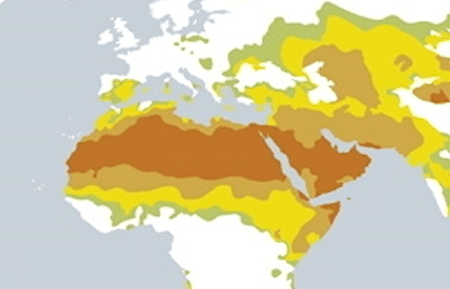
Global Aridity (Ministry of the Environment, Government of Japan)
The preoccupation with the age of manuscripts leads to the arbitrary prejudice against readings of locations which did not have favorable climates for preservation. Byzantine manuscripts had the disadvantage of being produced in areas which were not as suitable for manuscript preservation as Egypt. Looking at the two maps juxtaposed above reveals that Egypt alone has a hyper-arid climate (dark brown areas) of all the early centers of Christianity. Being alone in having a hyper-arid climate, Egypt had the most favorable climate for manuscript preservation. Only one manuscript (Uncial 0212) from before the 5th century survived to this day outside of Egypt (*Codex Vaticanus resided in the Vatican library from at least 1475, but it originally came from Egypt). Thus to base a critical Greek New Testament text on the “oldest extant manuscripts” is merely to base a critical text on the manuscripts of a church that just so happened to be resident in a place with the most favorable climate for preservation. However, there is no logical or spiritual nexus between being a recipient of the purest Greek New Testament text and being resident in a location with the most favorable climate for preservation. Thus, blindly preferring the oldest extant manuscripts for the composition of the New Testament text is an illogical practice that does not ensure the composition of the purest text.
Persecutions and Bible burnings
A vast number of early manuscripts were destroyed in the early persecutions of the Church. There were already ten major periods of persecution of Christians before Nicea:
- Persecution under Nero (64-68).
- Persecution under Domitian (90-96).
- Persecution under Trajan (112-117).
- Persecution under Marcus Aurelius (161-180).
- Persecution under Septimus Severus (202-210).
- Persecution under Decius (250-251).
- Persecution under Valerian (257-59).
- Persecution under Maximinus the Thracian (235-38).
- Persecution under Aurelian (270–275).
- Persecution under Diocletian and Galerius (303-324).
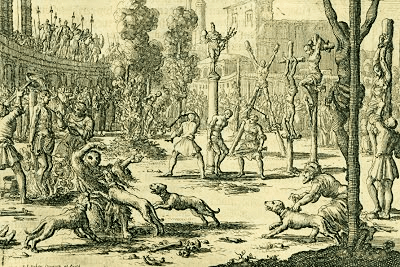
Persecution of Christians under Emperor Diocletian
One of the most ruthless of these persecutions was that of Diocletian in the early 4th century. Eusebius, Church historian of the same era, recorded that many "Scriptures" were burned during the Diocletian persecution. He writes in Church History (VIII:2):
"All these things were fulfilled in us, when we saw with our own eyes the houses of prayer thrown down to the very foundations, and the Divine and Sacred Scriptures committed to the flames in the midst of the market-places, and the shepherds of the churches basely hidden here and there, and some of them captured ignominiously, and mocked by their enemies. When also, according to another prophetic word, "Contempt was poured out upon rulers, and he caused them to wander in an untrodden and pathless way."
[...]
It was in the nineteenth year of the reign of Diocletian, in the month Dystrus, called March by the Romans, when the feast of the Saviour's passion was near at hand, that royal edicts were published everywhere, commanding that the churches be leveled to the ground and the Scriptures be destroyed by fire, and ordering that those who held places of honor be degraded, and that the household servants, if they persisted in the profession of Christianity, be deprived of freedom."
Many Christians who could not withstand the persecution handed over their Scriptures to the authorities to be publicly burned. There is even a term for these Christians who handed over the scriptures: "Traditors". Diocletian destroyed the Christian Scriptures which were stored in the churches. These pre-4th century manuscripts were undoubtedly the "best and most approved" manuscripts since they were the ones being kept in their houses of worship and learning. Since so many approved manuscripts were deliberately destroyed, the body of extant evidence most likely does not reflect the text which the early Church upheld to be the best text.
No scientific correlation between age and the number
of copyist errors
A single generation of transmission could span over many centuries
There is no scientifically ascertainable correlation between the age of a manuscript and the number of copyist errors. The typical theory is that whenever a manuscript is copied, there is possibility for errors to creep in. So as more generations of transmission occur, the more chances there will be for errors to occur. The NA/UBS editors preferred older manuscripts because older manuscripts supposedly have less generations of copying between them and the originals, and hence less copyist errors. While this assumption may appear to make sense at first, it is directly contradicted by confirmable evidence. Even common sense exposes the error of this thinking.
The earliest Byzantine witnesses for readings are about 100-300 years younger than the earliest Alexandrian witnesses for the same readings:
- Codex Alexandrinus Gospels (5th century)
- Codex Guelferbytanus B (5th century)
- Uncial 061 (5th century)
- Codex Petropolitanus Purpureus (6th century)
- Codex Sinopensis (6th century)
- Codex Guelferbytanus A (6th century)
- Codex Nitriensis (6th century)
- Purpureus Rossanensis (6th century)
- Codex Beratinus (6th century)
- Uncial 064 (6th century)
- Uncial 065 (6th century)
- Uncial 0246 (6th century)
- Uncial 0253 (6th century)
Due to the later dates (100-300 years), liberal textual critics assume that Byzantine manuscripts are generationally more removed from the originals than are Alexandrian copies. But the difference of 100-300 years is rather insignificant in the world of manuscript transmission. Here are some confirmable examples where multiple generations of copying did not occur in 100-300 years or more:
- Erasmus used manuscripts from the 12th century to compile his Textus Receptus in the 16th century. Thus in 400 years there was only one transmission process.
- Beza consulted Codex Bezae and Codex Claromontanus, two manuscripts from the 5th century, to compile his Textus Receptus edition in the 16th century. Thus in 1100 years there was only one transmission process.
- Westcott and Hort used Codex Vaticanus and Codex Sinaiticus from the 4th century to compile their Critical Greek Text in the 19th century. Thus in 1500 years there was only one transmission process.
If one generation of transmission could be as long as 400-1500 years, there is no basis to assume that Byzantine manuscripts from the 6th century are significantly more removed from the originals than are Alexandrian manuscripts from the 3rd century. Scribes in the 6th century had the same incentive as we do now to use manuscripts that were 400+ years old. A difference of 100-300 years is statistically insignificant. Since the original writings of the Apostles were given in the Byzantine areas, scribes in these areas could have copied the original manuscripts of the Apostles for many years until they finally decayed.
On the other hand, even the earliest Alexandrian manuscripts could be ten generations removed from the original writings. We simply do not know. Manuscripts do not come with tags indicating how many generations of copying went before them. Since a generation of transmission could be as short as one year and as long as 1500 years, it is unscientific to say that a younger manuscript is more removed from the originals than are older manuscripts, especially if the difference in age is as little as 100-300 years. Moreover, even ten generations of transmission under skilled scribes could yield less copyist errors than a single generation of transmission under unskilled scribes, so it is impossible to calculate the number of errors that could arise from the number of years. With so many variables at play, the fact that Byzantine manuscripts are later by a few hundred years is of little relevance.
Confirmed cases of carelessness by scribes of "oldest" manuscripts
Codex Sinaiticus is one of the oldest manuscripts. However, in it we see a number of omissions due to carelessness. The following omissions are accepted as mistakes by practically all textual critics. They are referenced here as examples of why "older" does not mean "more reliable".
1 Corinthians 13:1-2
A total of 32 Greeks words are omitted at 1 Corinthians 13:1-2.
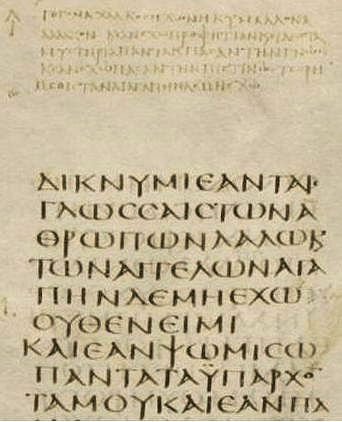
1 Corinthians 13:1-2 in Codex Sinaiticus
(Source: The Codex Sinaiticus Project Website: http://www.codexsinaiticus.org/en/ )
The text should read, "εαν ταις γλωσσαις των ανθρωπων λαλω και των αγγελων αγαπην δε μη εχω γεγονα χαλκος ηχων η κυμβαλον αλαλαζον και εαν εχω προφητειαν και ειδω τα μυστηρια παντα και πασαν την γνωσιν και εαν εχω πασαν την πιστιν ωστε ορη μεθιστανειν αγαπην δε μη εχω ουδεν ειμι " but the scribe of Sinaiticus omitted the underlined words. When the scribe finished copying the first "αγαπην δε μη εχω", his eyes jumped to the second "αγαπην δε μη εχω" and resumed copying from there. A later scribe inserted the omitted words in the top margin.
Luke 10:32
Luke 10:32 is omitted.

Luke 10:32 in Codex Sinaiticus
(Source: The Codex Sinaiticus Project Website: http://www.codexsinaiticus.org/en/)
Here, the scribe omitted all of verse 32 by skipping the words in between the "αντιπαρηλθεν" at the end of verse 31 and the "αντιπαρηλθεν" at the end of verse 32:
"κατα συγκυριαν δε ιερευς τις κατεβαινεν εν τη οδω εκεινη και ιδων αυτον αντιπαρηλθεν ομοιως δε και λευιτης γενομενος κατα τον τοπον ελθων και ιδων αντιπαρηλθεν σαμαρειτης δε τις οδευων ηλθεν κατ αυτον και ιδων αυτον εσπλαγχνισθη" (Luke 10:31-33)
Luke 17:35
Luke 17:35 is omitted.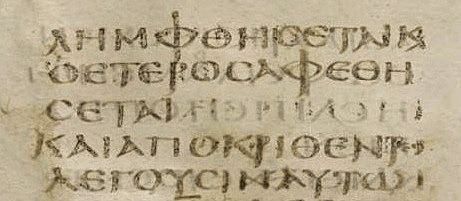
Luke 17:35 in Codex Sinaiticus
(Source: The Codex Sinaiticus Project Website: http://www.codexsinaiticus.org/en/)
Here the following underlined words were omitted because "αφεθησεται" appears twice:
"λεγω υμιν ταυτη τη νυκτι εσονται δυο επι κλινης μιας ο εις παραληφθησεται και ο ετερος αφεθησεται εσονται δυο αληθουσαι επι το αυτο η μια παραληφθησεται η δε ετερα αφεθησεται" (Luke 17:34-35)
John 6:55
Important words are omitted at John 6:55.

John 6:55 in Codex Sinaiticus
(Source: The Codex Sinaiticus Project Website: http://www.codexsinaiticus.org/en/)
This passage ought to say, "η γαρ σαρξ μου αληθως εστιν βρωσις και το αιμα μου αληθως εστιν ποσις (For my flesh is meat indeed, and my blood is drink indeed)." However, Sinaiticus reads, "η γαρ ϲαρξ μου αληθωϲ εϲ τι ποσις" (For my flesh is drink indeed)." This nonsensical reading arose when the scribe skipped everything in between the first "αληθως" and the second "αληθως".
John 16:15
John 16:15 is omitted.
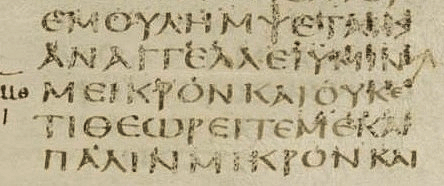
John 16:15 in Codex Sinaiticus
(Source: The Codex Sinaiticus Project Website: http://www.codexsinaiticus.org/en/ )
The scribe skipped the following underlined words of John 16:15 due to the repetition of the same words:
"εκεινος εμε δοξασει οτι εκ του εμου ληψεται και αναγγελει υμιν παντα οσα εχει ο πατηρ εμα εστιν δια τουτο ειπον οτι εκ του εμου ληψεται και αναγγελει υμιν μικρον και ου θεωρειτε με και παλιν μικρον και οψεσθε με οτι εγω υπαγω προς τον πατερα" (John 16:14-16)
The irony of modern critical texts
Modern critical texts prove that the "new" can contain the "old"
Later manuscripts can contain early readings the same way that the NA/UBS text contains early readings. The date of a manuscript does not indicate the date of the parent copies used by the copyist. The NA/UBS text is a "late text", being a product of the 19th and 20th centuries. The NA/UBS text itself is late although its readings are early (agreeing with early uncials and papyri). Thus to accept that the late 19th-20th century NA/UBS text contains early readings, one would have to accept the proposition that late texts can contain early readings. Thus to be open-minded one would have to admit that other late texts (i.e. Byzantine manuscripts) may also contain early readings.
The fallacy of NA/UBS editors is the supposition that they alone in history have attempted and succeeded in identifying early readings. NA/UBS editors did not seem to think that Reformation scholars (in the 15th century) had opportunities to collate ancient manuscripts which are no longer extant, and going further back, that Byzantine scholars (from the 4th to the 15th centuries) had opportunities to collate ancient manuscripts which were no longer extant even to the Reformation scholars. The biblical assumption, however, is that the true Church has always existed throughout history (Matthew 16:18) and that godly and competent scholars in every age of the Church collated manuscripts of the past (which may not be extant today) to preserve the pure words of God for their age. Thus Christians who believe in Christ' word about the Church and his ability to preserve his words ought to receive the text which the true Church from a previous age approved as the preserved text. The Textus Receptus is without a doubt the text that was considered the preserved text by the true and soul-saving church of the Reformation.
Conclusion
The NA/UBS editors, such as Bruce Metzger, gave the age of manuscripts the utmost importance at the near exclusion of all other factors, such as the evidence of patristic quotes, early translations, and the majority of manuscripts. Today, this same preoccupation with the age of manuscripts is shared by an entire generation of Christian leaders who learned textual criticism through Bruce Metzger's primer, The Text of the New Testament: Its Transmission, Corruption, and Restoration. However, the theory that the purest Greek New Testament text can be found in the oldest extant manuscripts does not stand up to scrutiny.

